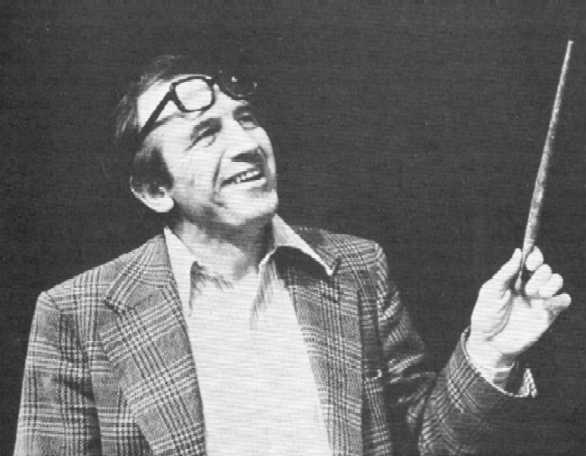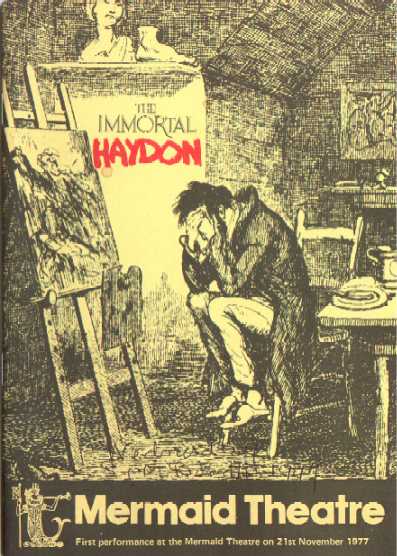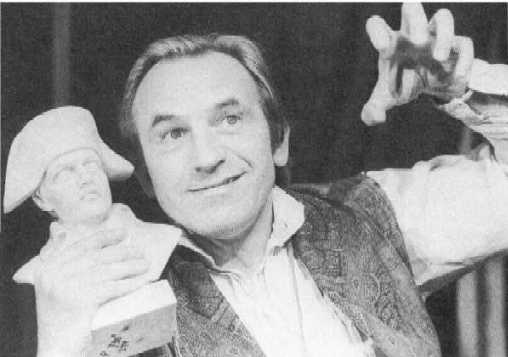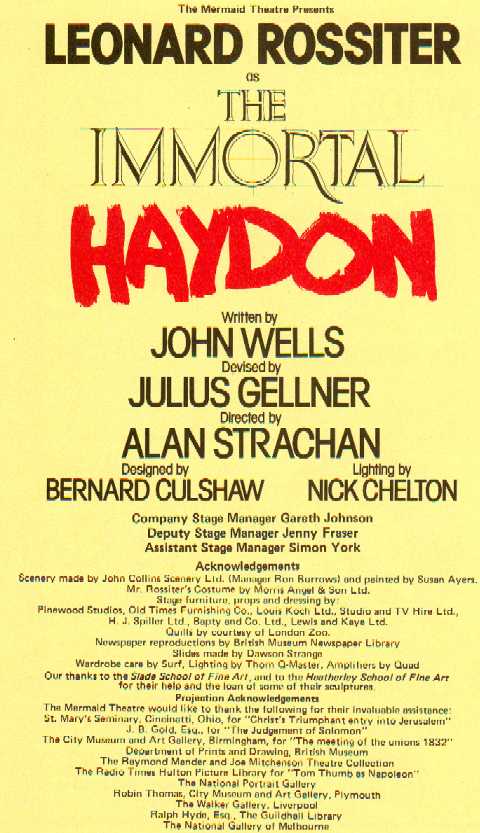
|
|
~ |
|
~ |
|
The Life & Career of Leonard Rossiter
The Immortal Haydon

Written by John Wells
Devised by Julius Gellner
Directed by Alan
Strachan
November 1977
Mermaid Theatre, London
January 1978
Greenwich Theatre, London
"The great difficulty is first to win a reputation; the next to keep it while you live; and the next to preserve it after you die, when affection and interest are over, and nothing but sterling excellence can preserve your name. Never suffer youth to be an excuse for inadequacy, nor age and fame to be an excuse for indolence."
|
|
 In a year in which he continued to portray his two most famous
characters
- the landlord Rigsby in Rising Damp, and the eponymous frustrated
commuter
in The Fall And Rise Of Reginald Perrin - Leonard Rossiter also
undertook
a role in 1977 in which, despite a career of twenty-five years, he had
no previous experience: a one-man show. It was a mammoth undertaking,
but
one which Leonard relished, and one which the critics adored. The
Immortal
Haydon was a play about the life and works of the English painter and
diarist
Benjamin Robert Haydon, friend of some of the most influential artists
and poets of our time, yet savaged by critics - a genius only in his
own
eyes.
In a year in which he continued to portray his two most famous
characters
- the landlord Rigsby in Rising Damp, and the eponymous frustrated
commuter
in The Fall And Rise Of Reginald Perrin - Leonard Rossiter also
undertook
a role in 1977 in which, despite a career of twenty-five years, he had
no previous experience: a one-man show. It was a mammoth undertaking,
but
one which Leonard relished, and one which the critics adored. The
Immortal
Haydon was a play about the life and works of the English painter and
diarist
Benjamin Robert Haydon, friend of some of the most influential artists
and poets of our time, yet savaged by critics - a genius only in his
own
eyes.
It was
a radio programme tribute to Haydon's life (A Great Canvas, written and
presented by Robert Gittings), that originally moved the Mermaid
Theatre
in London's Puddle Dock to commission The Immortal Haydon. Based on
Haydon's
twenty-six volumes of diaries and notebooks, and also his monumental,
albeit
half-completed autobiography, the play was written by the great
satirist
and comedian John Wells, a writer who had long been associated with the
1960s satire explosion along with David Frost, John Bird and John
Fortune
(Wells is probably best remembered for his uncanny portrayal of Denis
Thatcher
(husband of former Prime Minister Margaret) in the sitcom Anyone For
Denis?
Wells died from cancer in 1998). John Wells wrote The Immortal Haydon
with
Leonard Rossiter in mind as the lead role. "I suppose the first time I
really went mad about Len was seeing him as Arturo Ui", John remembers.
"He had an extraordinary power in that he could actually bring the
audience
to him. He didn't go out to the audience, he could actually bring them
in, by the intensity of his concentration."
Devised
for the stage by Julius Gellner, the scripts were honed to perfection
by
Wells, Gellner and Leonard himself, planning the changes of tempo and
variations
of pace called for in the presentation of the turbulent life  of
the struggling artist. The large stage at the Mermaid was transformed
into
Haydon's studio: a jumble of easels, busts, statues and papers.
Leonard,
clad in red waistcoat and velvet house slippers, with spectacles
hanging
around his neck, perfectly brought Haydon to life with his anecdotes
and
vitriolic railings at the Royal Academy and society in general. With
the
entire script of the two-hour show learned and memorised in a few days,
Leonard gave an outstanding performance, minutely honing his every
movement
and inflection of speech, and letting his frustrations build and his
weariness
set in until, in the final scene, the painter ends it all with a
revolver
to his head, the stage being plunged into darkness and the artist's
name
splashed across a screen in blood. (Note: The BBC2 arts programme Arena
made a documentary following Leonard during his rehearsals for this
play
in 1977).
of
the struggling artist. The large stage at the Mermaid was transformed
into
Haydon's studio: a jumble of easels, busts, statues and papers.
Leonard,
clad in red waistcoat and velvet house slippers, with spectacles
hanging
around his neck, perfectly brought Haydon to life with his anecdotes
and
vitriolic railings at the Royal Academy and society in general. With
the
entire script of the two-hour show learned and memorised in a few days,
Leonard gave an outstanding performance, minutely honing his every
movement
and inflection of speech, and letting his frustrations build and his
weariness
set in until, in the final scene, the painter ends it all with a
revolver
to his head, the stage being plunged into darkness and the artist's
name
splashed across a screen in blood. (Note: The BBC2 arts programme Arena
made a documentary following Leonard during his rehearsals for this
play
in 1977).
The
play
followed very closely the texts of Haydon's diaries (published in 1960)
and autobiography (published in 1847), giving a vivid, sometimes
painful,
portrayal of a man desperate for wider acclaim in a world that just
didn't
want to know. Born in Plymouth, Devon, on January 25th 1786, the son of
a bookseller, Benjamin Haydon showed a flair for painting at an early
age,
and became a student of the Royal Academy at the age of 19, exhibiting
his first picture two years later. Because of subsequent quarrels
within
the society, however, most of his later works were only ever shown at
private
exhibitions, if at all. It was Haydon's ambition to become the greatest
historical painter England had ever known, and devoted his life to
painting
extremely large, yet somewhat dull, canvases, including biblical and
classical
subjects such as "The Judgement Of Solomon" (1814), "Christ's Entry
Into
Jerusalem" (1820) and "The Raising Of Lazarus" (1823). In contrast, he
also produced paintings with humorous leanings, such as "Mock Election"
(1827) and "Punch, or May Day" (1829). Despite his dislike of
portraiture,
he had the Duke of Wellington sit for him, and his portrait of the poet
(and personal friend) William Wordsworth, "Wordsworth Musing On
Helvellyn"
(1842), was described by the poet himself as the best likeness of
him ever made.
Despite
his struggle for recognition, Haydon remained a minor figure of the
Romantic
era. When he opened a private exhibition at the Egyptian Hall in
Piccadilly,
more people went to see the celebrity American midget 'General Tom
Thumb'
(Charles Sherwood Stratton), who was appearing next door, than went to
see Haydon's paintings. His diary notes the humiliation: "April 21st
-Tom
Thumb had 12,000 people last week. B. R. Haydon 133 and a half (the
half
a little girl). Exquisite taste of the English people!" A month later
Haydon
"marched out before General Tom Thumb, a beaten but not conquered
exhibitor."
He had lost all £111 8s. 10d, the cost of the exhibition,
plunging
the painter further into debt. Even a century after his death, the bad
luck of Benjamin Haydon was still evident: The Judgement Of Solomon,
painted
in 1814 and one of Haydon's personal favourites, turned up at a London
auction room in 1960, rolled up in a dirty table-cloth, faded and
cracked,
and labelled as "Italian school, circa 1730". Luckily, a collector
realised
its true identity and the painting has now been restored.
For all
the negative press about Haydon, it has to be said that he had an
extensive
acquaintance among literary figures of his time, not least John Keats,
Charles Lamb, William Wordsworth and Elizabeth Barrett Browning, to
whom
he entrusted his writings after his death. It was into these diaries
that
Haydon's perpetual frustrations and anger at society poured, detailed
and
frank. He recorded his moments of exaltation, reflections on the nature
of his 'genius', his social triumphs and expenses. One of the most
famous
passages was
his account of his "Immortal Dinner" on December 28th 1817, attended by
many of his famous friends (see link below). His talent for writing,
especially
his keen eye for character, is usually praised more often than the
productions
at his easel. He lectured often up and down the country, advocating
social
concepts of art that anticipated those of Willam Morris and John
Ruskin,
and was instrumental in the establishment of many public art galleries
and in the foundation of numerous Schools of Design. He was even
commissioned
to write an article on painting for the Encyclopedia Britannica
(seventh
edition). Haydon's devotion to the education of the people in art
resulted
in him becoming a Freeman of Plymouth, his native city, but also
resulted
in deep financial debt. It was his financial incompetence that was to
be
his ultimate downfall, together with his violent and self-absorbed
personality,
and the continued failure of his artistic ambitions. Even Haydon's
first
suicide bid, with a cut-throat razor, was unsuccessful, but a second
attempt,
this time with revolver, brought the desired effect. His diary notes:
"When
a man is no longer anxious to do better then, well, he is done for."
Benjamin
Haydon died on June 22nd, 1846.

Leonard's Role
Remembered:
"He was restlessly
perfectionist,
dedicated to getting it right...At home or out to dinner with friends,
all the energy seemed to go into jokes, telling stories, laughing,
talking
and enjoying himself with no sense ever of any tension; on stage all
the
energy was disciplined, directed to achieving minutely precise
sensations
in himself and the audience...The most 'professional' actor I have ever
known." - John Wells, author.
"..It was, in Len's hands, much more than a tour-de-force and a prodigious feat of memory. He captured not just the absurdity of the man but also something of a tragic grandeur in a spirit whose sense of reality gradually dissolved into terrifyingly isolated madness" - Alan Strachan, director.
"I will remember Len, not for his commercials, not for Reggie Perrin, not for Rising Damp, not even for Arturo Ui, but for his performance at The Mermaid in the one-man show written by John Wells about the painter Benjamin Haydon...I felt that all the human comedy, all the human tragedy, all the absurdity of mankind's pretensions were illuminated for us by Leonard... I was certain that night that I was seeing not just a very fine actor, but one of the all-time greats." - David Nobbs, author, the Reginald Perrin novels.
Critical Reviews:
"His performance is witty
and impassioned, falling sometimes into inarticulate sounds that lead
nowhere,
but generally fresh and spontaneous." - Ned Chaillet, The Times.
"Mr. Rossiter's
masterful
performance catches that inane sense of mission possessed by reforming
fanatics at full belt."
- Michael Coveney, Financial
Times.
"There's no doubt Mr. Rossiter has scored a personal triumph with his one-man show, for it is a mammoth undertaking, requiring subtle nuances of timing... The real interest of the performance is in watching Mr. Rossiter extending his range as an actor. B.R. Haydon was fascinating enough, but I was more impressed by Mr. Rossiter, who moves into the Theatrical First Division with this piece of work." - Douglas Blake, The Stage & Television Today.
"...[H]e cajoles and
roars
and jokes his way thorugh it with a brilliant series of
cameos...Rossiter's
performance is more than a demonstration of the talents of a superb
character
actor. He gets convincingly inside the sometimes cheerful, sometimes
despairing
hopelessness..." - Christopher Dodd, The Guardian.
Links:
"The
Immortal Dinner"
Selected
Poetry and Writings
Text (c) Paul Fisher
Pictures (c) their
respective
owners.